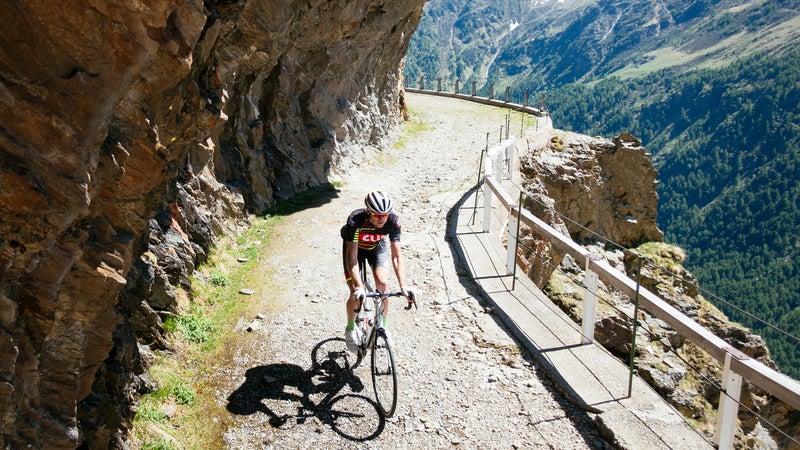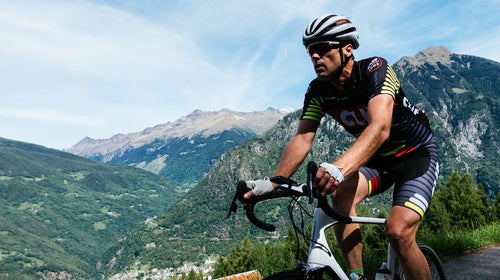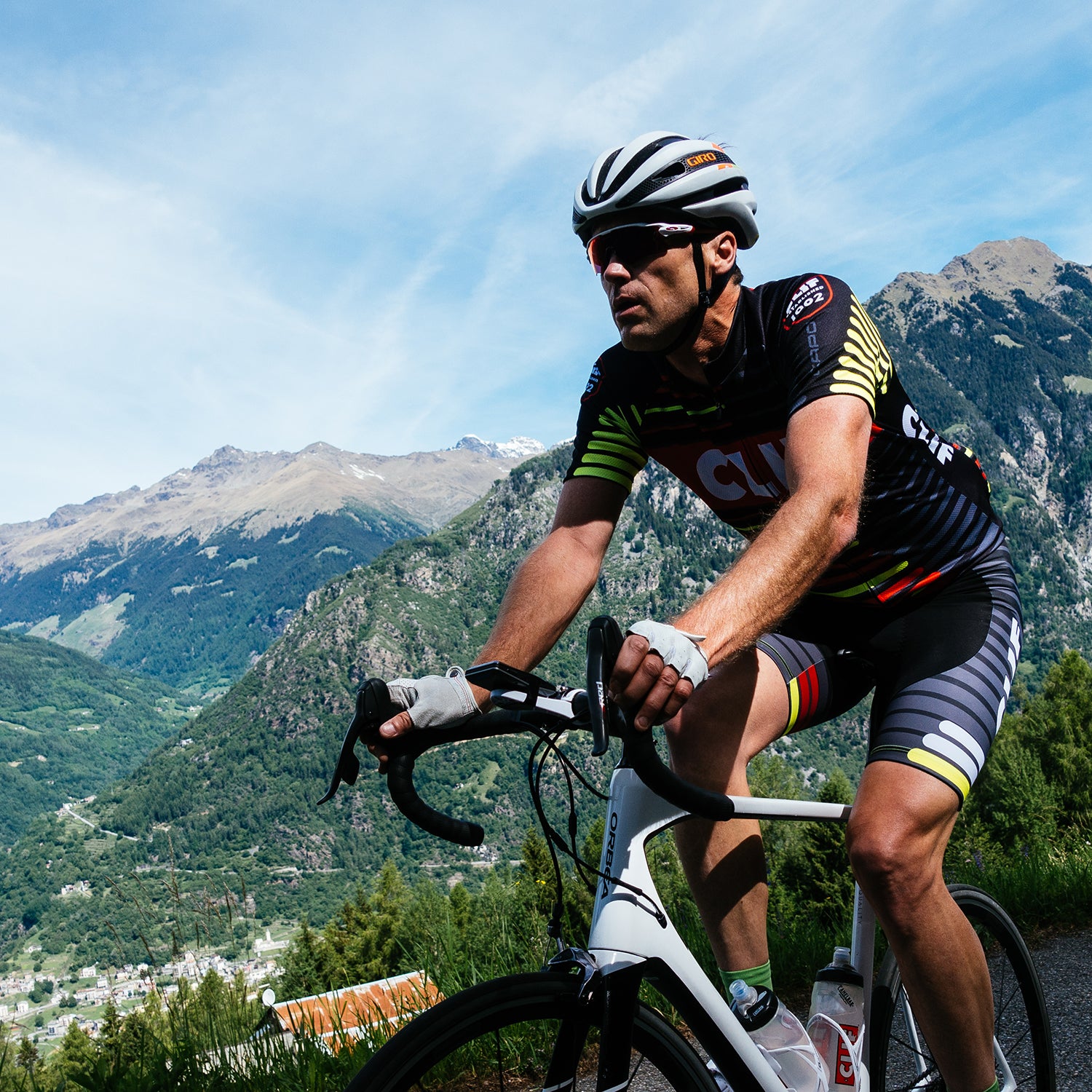I had been warned about the . The road, despite its 34 switchbacks, 8.5 percent average grade, and vertical ascent to more than 8,000 feet above sea level—the highest paved stretch in Switzerland—often dwells in the shadow of more famous neighbors like the Passo di Stelvio or the Passo di Gavia. It was what Tom Dumoulin, the eventual , had so painfully struggled up after famously stopping for a five-alarm “nature break.”
And yet there I was, three-quarters of the way up, in full bonk. Cycling photographer pedaled alongside, chirpy as a spring robin, and offered to play some music. I think it was Johnny Cash—it didn’t help. With my silence, I willed her to move on so I could suffer alone. She did, and I did. I finally came across the van, where Waldek Stepniowski, the gregarious Pole who manages the pro team, plied with me enough Cokes and Clif Bars to get me over the top and into Italy.
If this sounds a bit like product placement—well, it is. I was a guest of Clif Bar founder Gary Erickson, along with his wife and company co-owner Kit Crawford, a group of employees, and Clif Bar–sponsored athletes, on a trip to celebrate the company’s 25th anniversary in the corner of the Dolomites where the founding idea had taken root.

Back at our cozy hotel in Bormio, with his Brittany spaniel Cima (“top” in Italian) at his feet, Erickson recalled with a laugh that he had endured very same experience on the Umbrail. “Our goal was to ride the Gavia, the Stelvio, and the Umbrail in one day,” he says. Upon summiting the Stelvio, his riding partner told Erickson he was done. Erickson proceeded alone. Back then, the pass was not paved. “I get about halfway up, and the motor shuts off,” says Erickson. “It’s foggy, it’s raining, it’s freezing, and there are no cars.” Nor was there was a support vehicle loaded with refreshments; the whole ethos was to ride self-sufficiently, with whatever could be packed in a shoebox. Every pedal stroke was an ordeal. “I was ready to cry,” says Erickson.
“Born on a bike” goes the Clif slogan, though it just as easily could have been “born on a bonk.” It was his various travails with portable nutrition that convinced Erickson he could create a better bar—this in the days when ruled the still-slender market segment. The rest is history: Clif Bar went on to eclipse PowerBar, was nearly sold to Quaker, and now stands atop the “portable lifestyle and health bar” category, with estimated annual revenues (the privately held company does not release figures) upwards of $500 million.
Erickson turned his cycling heritage—freewheeling, lightly encumbered, semi-planned jaunts through Italy’s unpaved roads—into a corporate ethos.
While a 25th anniversary victory lap seems well deserved, the market Clif helped to invent has become highly competitive—and crowded. “In our category alone, there’s probably 200 companies,” says Erickson. “We’re always looking over our shoulder.”
Erickson turned his cycling heritage—freewheeling, lightly encumbered, semi-planned jaunts through Italy’s unpaved roads—into a corporate ethos. But is it possible to maintain that same spirit when your formerly garage-based startup has 1,200 employees? “We always want to be a challenger brand,” says Erickson. “We always want to go after someone bigger.”
Clif sees its primary targets as the big food companies like and , which still dominate the grocery store breakfast aisles, rather than the scores of upstart rivals (everything from to to to that homemade hemp-chia concoction your neighborhood health food store sells) that have crowded the portable nutrition segment. “We’re not going after them, although they are coming after us,” says Erickson. “And we don’t want to lose any market share.” By remaining family and employee owned, he says, Clif has “been able to stay nimble.” Goliath, notes Erickson, was too big to match David’s speed. “We trust ourselves, trust each other, and trust our team to make bold decisions without layers and layers of red tape.”
Hence the endless drive to innovate. Innovation does not have to mean new. As Erickson notes, he didn’t invent the energy bar; he just made what he thought was a better one. But knowing how and where to find the next good idea is key. For Clif, that means listening to athletes. , for example, the energy chews released in 2005 (Erickson notes that Clif was second to market, after Sharkies), came about because the company was hearing complaints about energy gels: “It’s messy. What do I do with them after it’s open? The inside of my jersey pocket is getting messy.” Bloks simply changed the vehicle for energy delivery into something more familiar (read: Gummi bears) and palatable.
Innovation does not have to mean new. As Erickson notes, he didn’t invent the energy bar; he just made what he thought was a better one.
Like in a race, knowing when to make a move is key. A few years ago, Erickson’s brother, an engineer who works with the company, sent pictures of a new food production process. “He said, ‘We took a chocolate Clif Bar and put peanut butter inside it.’” (Not so easy to do, says Erickson, with Clif’s “tough dough.”) That was as far as it went. Fast-forward a few years to the nut butter craze, and suddenly the race was on. (In an homage to Erickson, the packaging for the nut butter–filled bars features an image of a cyclist on the sole remaining unpaved stretch of the Passo di Gavia.)
Plenty of paths didn’t turn out. As Erickson might say, taking wrong turns is part of the journey. The company tried twice to create a Clif drink—first Rapid Quench, and then Clif Quench—but neither worked out. “RTD [ready-to-drink] is a very difficult category. It requires a whole different distribution thing,” says Erickson. The first launch of the Mojo bar had some underperforming flavors, like curried cashew and spicy salsa peanut. To this day, Erickson isn’t sure “whether those way-out flavors were ahead of their time, or people just don’t want to see curry in a bar.”
The search for new roads continues. “We’re getting close to tapping out on concepts for athletes,” says Erickson. But a much larger market for healthy organic snacking looms. While the company’s energy food line—for example, in a pouch), he says, “haven’t done that well,” Erickson says several new rollouts are planned for next year. But, he adds, “bars will always be our sweet spot.”


